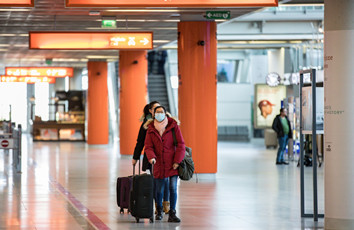全球第二季度减少4亿个全职工作
联合国国际劳工组织近日发出警告,新冠肺炎疫情造成的就业损失远超先前估计,全球在今年第二季度损失了4亿个全职工作,美洲形势尤为严峻。同时,新冠肺炎疫情还加剧了职场性别不平等。

The coronavirus pandemic is expected to have resulted in a 14% drop in global working hours in the second quarter of 2020, the International Labour Organization has said.
国际劳工组织近日称,2020年第二季度,新冠肺炎疫情预计将导致全球工作时间减少14%。
The United Nations’ labor agency said this updated fall in working hours was the equivalent of 400 million full-time job losses globally in the second quarter, based on a standard 48-hour working week.
联合国国际劳工组织称,按每周工作48小时的标准计算,最新统计的工作时间降幅相当于第二季度全球减少4亿个全职工作岗位。
This marked a “sharp increase” on the 10.7% fall in working hours, or 305 million job losses, that the ILO forecasted for that period, in its previous report on the impact of Covid-19 on the labor market, published in May.
国际劳工组织5月份发布的关于新冠肺炎对劳动力市场影响的报告预测称,今年第二季度全球工作时间预计减少10.7%(即3.05亿个全职工作)。而最新数据与之相比大幅上升。
In this fifth edition of its “Covid-19 and the world of work” monitor, the ILO said that the Americas were the most affected region, with an estimated 18.3% drop in working hours, or 70 million full-time jobs.
在第五版“新冠肺炎与全球工作”监测报告中,国际劳工组织表示,美洲是受影响最严重的地区,工作时间预计减少了18.3%,即7000万个全职工作。
The working-hour losses are calculated based on the ILO’s “nowcasting” model, which is statistical forecasting drawing on real-time economic and labor market data. It uses the fourth quarter of 2019 as the basis for falls.
工作时间损失是根据国际劳工组织的“即时预测”模型计算的,该模型利用实时经济和劳动力市场数据进行统计预测,并与2019年第四季度做对比。

In the first quarter, the ILO calculated a 5.4% fall in working hours worldwide, equating to 155 million jobs, in comparison to the fourth quarter of last year.
据国际劳工组织计算,今年第一季度全球工作时间较去年第四季度减少5.4%,相当于1.55亿个全职工作。
The ILO said there were multiple factors causing this global decline such as, shorter working hours, temporary leave - or furlough - as well as unemployment and “inactivity.”
国际劳工组织表示,造成这一数据下降的因素有很多,如工作时间缩短、临时休假(或暂时解雇)、失业和“不活跃”等。
2020年下半年全球职场展望
The ILO’s report also outlined three different scenarios for a labor market recovery in the second half of the year.
国际劳工组织的报告还概述了今年下半年劳动力市场复苏的三种不同情景。
The baseline model projects a 4.9% decline in working hours, or 140 million job losses, compared to the fourth quarter of 2019. This scenario is assuming a rebound in economic activity according to existing forecasts, the lifting of workplace lockdown restrictions, in addition to a recovery in consumption and investment.
根据基线模型预测,与2019年第四季度相比,今年下半年全球工作时间将减少4.9%,相当于损失1.4亿个全职工作。这一设想是在假定经济活动根据现有预测出现复苏、解除工作场所封锁限制以及消费和投资复苏的前提下得出的。
A pessimistic scenario would see an estimated 11.9% fall in working hours, or 340 million job losses. This is based on there being a second wave of coronavirus cases, prompting the return of lockdown restrictions, therefore meaning a “significantly slow recovery.”
按照悲观的估计,全球工作时间将减少11.9%,相当于损失3.4亿个全职工作。这是基于出现第二波新冠疫情,促使封锁限制恢复,因而“恢复非常缓慢”的前提下得出的。
The optimistic model would work out to an estimated 1.2% decrease in working hours, or 34 million job cuts. This best-case scenario would be the result of workers’ activities resuming quickly, “significantly boosting aggregate demand and job creation.”
按照乐观的估计,预计全球工作时间将减少1.2%,相当于损失3400万个全职工作。在职员尽快复工,“从而显著提振总需求和创造就业机会”的前提下,才会出现这种最乐观的情况。
加剧职场性别不平等
The ILO report also highlighted the disproportionate effect of the pandemic on female workers. It pointed out that 510 million, or 40%, of all employed women globally work in the four most hard-hit sectors by the coronavirus crisis, compared to 36.6% of men.
国际劳工组织的报告还强调说,新冠肺炎疫情对女性的影响更大。该机构指出,全球有5.1亿女性(占全体就业女性的40%)在受到新冠疫情冲击最大的四个行业工作,而在男性中这一比例为36.6%。
The fact that women also dominate the domestic work, health and social care sectors, has meant that they are at greater risk of infection and transmission of the virus and of losing income. Meanwhile, the distribution of unpaid care work of children, for example, has become more unequal during the pandemic, made worse by the closure of schools and care services.
女性在家务、卫生保健和社会护理部门也占主导地位,这意味着她们感染和传播病毒以及失去收入的风险更大。与此同时,无偿照料儿童等任务分配在新冠肺炎疫情期间更加不平等,学校和育儿机构的关闭使情况恶化。
The ILO said this impact on women risked undoing some of the progress on gender equality in recent decades and exacerbating work-related gender inequalities.
国际劳工组织表示,这种对女性的影响可能会破坏近几十年来在性别平等方面取得的一些进展,并加剧职场性别不平等。


